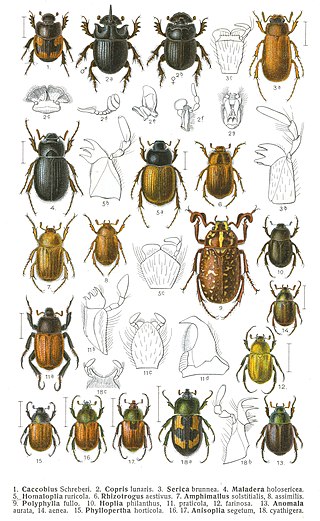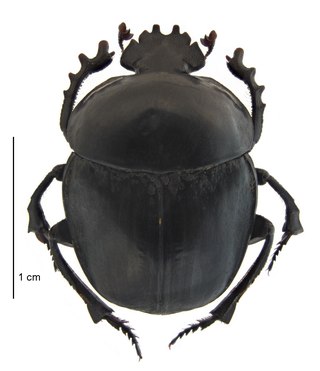
The family Scarabaeidae, as currently defined, consists of over 35,000 species of beetles worldwide; they are often called scarabs or scarab beetles. The classification of this family has undergone significant change in recent years. Several subfamilies have been elevated to family rank, and some reduced to lower ranks. The subfamilies listed in this article are in accordance with those in Catalog of Life (2023).

Stag beetles are a family of about 1,200 species of beetles in the family Lucanidae, currently classified in four subfamilies. Some species grow to over 12 centimetres, but most to about 5 cm (2 in).

The Curculionidae are a family of weevils, commonly called snout beetles or true weevils. They are one of the largest animal families with 6,800 genera and 83,000 species described worldwide. They are the sister group to the family Brentidae.

The longhorn beetles (Cerambycidae), also known as long-horned or longicorns, are a large family of beetles, with over 35,000 species described. Most species are characterized by extremely long antennae, which are often as long as or longer than the beetle's body. In various members of the family, however, the antennae are quite short and such species can be difficult to distinguish from related beetle families such as the Chrysomelidae. The scientific name of this beetle family goes back to a figure from Greek mythology: after an argument with nymphs, the shepherd Cerambus was transformed into a large beetle with horns.

Bostrichoidea is a superfamily of beetles. It is the type superfamily of the infraorder Bostrichiformia.

The minute tree-fungus beetles, family Ciidae, are a sizeable group of beetles which inhabit Polyporales bracket fungi or coarse woody debris. Most numerous in warmer regions, they are nonetheless widespread and a considerable number of species occur as far polewards as Scandinavia for example.

Coccotrypes dactyliperda, the date stone beetle, palm seed borer, or button beetle, is an insect belonging to the bark beetles (Scolytinae). It feeds on and spends part of its life cycle in dates, the fruits of the date palm. Because of its damage to dates, it is considered a pest.

Ateuchus is a genus of some 100 species of New World scarab beetles (Scarabaeidae) in the subfamily Scarabaeinae. They are found mainly in the Neotropics.

Chrysochus auratus, the dogbane beetle, of eastern North America, is a member of the leaf beetle subfamily Eumolpinae. It is primarily found east of the Rocky Mountains. Its diet mainly consists of dogbane (Apocynum), specifically Apocynum cannabinum and Apocynum androsaemifolium, and occasionally it eats milkweed. It is 8-11 mm long and has a convex, oval shape.

Sceliages, Westwood,, is a sub-genus of the Scarabaeus dung beetles, and are obligate predators of spirostreptid, spirobolid and julid millipedes, having renounced the coprophagy for which they were named. The genus is near-endemic to Southern Africa, Sceliages augias exceptionally ranging as far north as the Democratic Republic of Congo.

Clambidae is a family of beetles. They are known commonly as the minute beetles or the fringe-winged beetles. They are found worldwide on every continent except Antarctica.

Xylosandrus compactus is a species of ambrosia beetle. Common names for this beetle include black twig borer, black coffee borer, black coffee twig borer and tea stem borer. The adult beetle is dark brown or black and inconspicuous; it bores into a twig of a host plant and lays its eggs, and the larvae create further tunnels through the plant tissues. These beetles are agricultural pests that damage the shoots of such crops as coffee, tea, cocoa and avocado.

Ateuchus guatemalensis, is a species of dung beetle belonging to the family Scarabaeidae. It is found in Guatemala, Honduras, Nicaragua, and the Mexican states Chiapas and Oaxaca.
Eustra shanghaiensis, is a species of flanged bombardier beetle belonging to the family Carabidae. It is endemic to China.
Ateuchus texanus is a species of dung beetle in the family Scarabaeidae.
Ateuchus lecontei is a species of dung beetle in the family Scarabaeidae.
Ateuchus histeroides is a species of dung beetle in the family Scarabaeidae.

Sicoderus bautistai is a species of weevil in the genus Sicoderus indigenous to the island of Hispaniola. It is closely related to the species S. ramosi, S. guanyangi, and S. turnbowi. Its appearance has been described as similar to that of "black, shiny ants".
Gymnopleurus parvus, is a species of dung beetle found in India, Sri Lanka and Bangladesh.
Cadmus (Brachycaulus) colossus, or Cadmus colossus, is a species of beetle in the subfamily, Cryptocephalinae, or case-bearing leaf beetles, and the subgenus, Brachycaulus. It was first described by Félicien Chapuis in 1875, from a male specimen collected at Port Denison. It is native to Australia, being found in New South Wales and Queensland.














